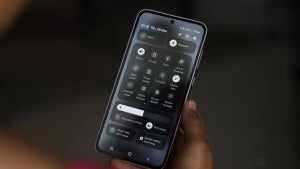![]() One of the more developer-focused demos that I saw at GDC 2013 was for Intel’s Perceptual Computing SDK. This software developers kit is for creating gesture-based commands with a specifically designed webcam. Somewhat like what the Kinect and new PlayStation 4 Eye, the Intel Perceptual Computing software will allow you to control computers through the use of gestures, voice, and eye tracking.
One of the more developer-focused demos that I saw at GDC 2013 was for Intel’s Perceptual Computing SDK. This software developers kit is for creating gesture-based commands with a specifically designed webcam. Somewhat like what the Kinect and new PlayStation 4 Eye, the Intel Perceptual Computing software will allow you to control computers through the use of gestures, voice, and eye tracking.
It’s an interesting development for software and in some ways, its going against touch controls for Windows 8. Barry Solomon, from Intel’s Visual Computing Product Management Software and Solutions Group, explained that the SDK currently uses a webcam designed by Creative to work with the SDK and that they are looking beyond Windows 8 and into new ways for interaction.
Perceptual Computing is still early in development and it’s going to be some time before the software is integrated with Intel hardware.
Solomon demoed parts of the SDK showing off how the camera can track different movements. While Creative makes the developer camera now, I was told that Intel is looking for ways to integrate it into laptops in the future. Since the SDK doesn’t have a lot third party development behind it yet, there were only a few demos that they could show off. The SDK isn’t vaporware, but it’s still too early to tell what it could be used for beyond controlling Windows 8 for basic commands.
The second demo was a custom build of Portal to show how gaming could be affected by integrating the SDK. The Portal demo was more of a concept than a full level, but also another window into the potential of using Perceptual Computing. It was interesting that Solomon talked about the technology being used beyond just computers like smartphones and tablets. It wouldn’t be surprising if Intel could get the camera small enough to fit into a mobile device or tablet to use gestures.
Samsung’s Air Gesture and Smart Scroll/Pause are very similar to Perceptual Computing, but the difference will be lost on the normal consumer. Intel may be looking to develop the technology beyond common features for mobile devices and allow user to natively control their computers by using gesture and voice. Adding in Perceptual Computing could result in an overflow of interfaces with keyboard, touchpad, and touchscreens already common methods for people to interact with their devices.
Intel Perceptual Computing is in early stages of development and has a long way to go, but it appears that Intel is putting a lot of effort to develop the SDK into something that will be widely used in Intel-supported devices.

